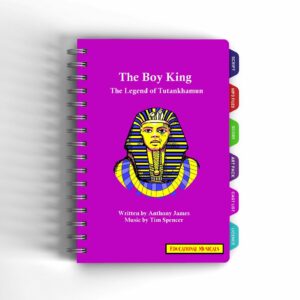Tutankhamun, also known as King Tut, is now one of the most famous pharaohs of ancient Egypt, all due to the discovery of his nearly intact tomb in the Valley of the Kings in 1922 by British archaeologist Howard Carter, which is why we have published a musical about him.
Egyptian Primary School Resource – The Boy King – The Legend of Tutankhamun
 The Boy King, Tutankhamun, is sometimes known as King Tut, is a story from Egypt 3,000 years ago. He was the son-in-law of Queen Nefertiti. It is estimated that he was only 9 when his reign began around 1360 B.C. He married a girl of 12 and died mysteriously at 19, some think of foul play. He is credited for re-establishing the old gods that had been banished by the unpopular King Akhenaten.
The Boy King, Tutankhamun, is sometimes known as King Tut, is a story from Egypt 3,000 years ago. He was the son-in-law of Queen Nefertiti. It is estimated that he was only 9 when his reign began around 1360 B.C. He married a girl of 12 and died mysteriously at 19, some think of foul play. He is credited for re-establishing the old gods that had been banished by the unpopular King Akhenaten.
The story starts in the Valley of the Kings, where archaeologist Howard Carter and his workers find the tomb of a long, lost king in 1922. In our show we then travel 3,330 years into the past to meet the nine-year-old boy who becomes the Pharaoh of all Egypt.
Together they try to re-establish the ways of the old gods, but Tutankhamun is murdered, at the wishes of a ghostly enemy, at the age of 19. Ascending to the Afterlife he meets the gods of ancient Egypt themselves. They then show the king that his story will be remembered, and his name will be known to children over 3,000 years into the future
The story of Tutankhamun is important is an important Egyptian Primary School Resource for several reasons. https://kids.nationalgeographic.com/history/article/king-tut
It is an interesting Egyptian Primary School Resource that will captivate your children.
The story of the discovery of Tutankhamun’s tomb is an interesting one. To help you we have History Bite on this, which you can use in class if you are a subscriber. If you are nota subscriber go to https://www.history-portal.com/member-registration/ The contents of the tomb alone would be the basis of a fascinating lesson that maybe will spark interest in history and archaeology.
Learning about Ancient Egypt:
The contents of his tomb have given us an intriguing picture of life, culture, and society of ancient Egypt.
Cross-Curricular Connections:
The story of Tutankhamun allows you to extend beyond history to other subjects such as geography, art, and even science. Your class can explore the geography of Egypt, learn about symbols and even create their own ancient Egyptian-inspired artwork, or be inspired to investigate the preservation of ancient artifacts.
Cultural Diversity:
Learning about ancient Egypt introduces students to a culture different from their own. This can foster an appreciation for diversity and a broader perspective on the world.
This Egyptian Primary School Resource allows the discovery of the different methods used by archaeologists to uncover and analyse historical artifacts. They can investigate learn the excavation techniques uses for the preservation of ancient artifacts
This Egyptian Primary School Resource Encourages Critical Thinking
By getting involved in putting on The Boy King it will encourage your students to ask questions about Tutankhamun’s life, his death, and the mysteries surrounding his reign that should create discussions and hopefully will promote critical thinking.
Which should be the start of a greater interest into ancient Egyptian history, such as the pyramids, mummification practices, the pharaohs’ role in society and of course the afterlife. If you are a subscriber, we have a further Egyptian Primary School Resources as a History Bite on “The Afterlife and the process of Mummification”.
Incorporating The Boy King – The Legend of Tutankhamun into you Egyptian Primary School Resources can create an engaging and informative learning experience that not only teaches about ancient Egypt but also fosters important skills and perspectives that students can carry with them throughout their education and beyond.
